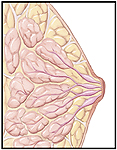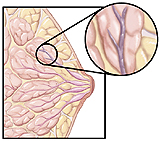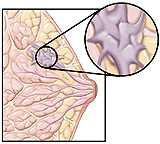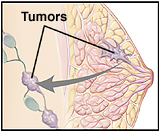Breast Cancer
Having breast cancer means that some cells in your breast are growing abnormally. Learning about the different types and stages of breast cancer can help you take an active role in your treatment.
Changes in Your Breast
Your entire body is made of living tissue. This tissue is made up of tiny cells. You can't see these cells with the naked eye. Normal cells reproduce (divide) in a controlled way. When you have cancer, some cells become abnormal, changing shape. These cells may divide quickly and spread into other parts of the body.

Normal breast tissue is made of healthy cells. They reproduce new cells that look the same.

Noninvasive breast cancer (carcinoma in situ) occurs when cancer cells are only in the ducts.

Invasive breast cancer occurs when abnormal cells move out of the ducts or lobules into the surrounding breast tissue.

Metastasis occurs when cancer cells move into the lymph nodes or bloodstream and travel to another part of the body.
FAQ: Mammograms
Q: What is a mammogram?
A: A mammogram is an x-ray of the breast. Mammograms can be used to check for breast cancer in women who have no signs or symptoms of the disease. This type of mammogram is called a screening mammogram. Screening mammograms usually involve two x-rays of each breast. They make it possible to detect tumors that cannot be felt. Screening mammograms can also find microcalcifications (tiny deposits of calcium) that sometimes indicate the presence of breast cancer.
Mammograms can also be used to check for breast cancer after a lump or other sign or symptom of breast cancer has been found. This type of mammogram is called a diagnostic mammogram. Signs of breast cancer may include pain, skin thickening, nipple discharge, or a change in breast size or shape. A diagnostic mammogram also may be used to evaluate changes found during a screening mammogram, or to view breast tissue when it is difficult to obtain a screening mammogram because of special circumstances, such as the presence of breast implants
Q: How are screening and diagnostic mammograms different?
A: Diagnostic mammograms take longer than screening mammograms because they involve more x-rays in order to obtain views of the breast from several angles. The technician may magnify a suspicious area to produce a detailed picture that can help the doctor make an accurate diagnosis.
Q: How can women who are low-income or uninsured obtain a screening mammogram?
A: Some state and local health programs and employers provide mammograms free or at low cost. For example, the Centers for Disease Control and Prevention (CDC) coordinates the National Breast and Cervical Cancer Early Detection Program. This program provides screening services, including clinical breast exams and mammograms, to low-income, uninsured women throughout the United States and in several U.S. territories. Contact information for local programs is available on the CDCs Web site at http://apps.nccd.cdc.gov/cancercontacts/nbccedp/contacts.asp or by calling the CDC at 1-800-CDC-INFO (1-800-232-4636).
Information about low-cost or free mammography screening programs is also available through NCI's Cancer Information Service (CIS) at 1-800-4-CANCER (1-800-422-6237). Women can also check with their local hospital, health department, women's center, or other community groups to find out how to access low-cost or free mammograms.
The health information provided online represents common treatments and procedures, but DOES NOT indicate specific instructions for Rockcastle Regional patients. You should NOT utilize the information as a substitute for medical advice. Always follow your doctor's advice and ask about what to expect from treatment at Rockcastle Regional.